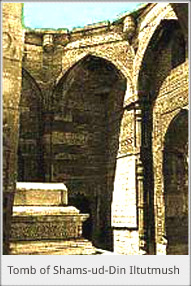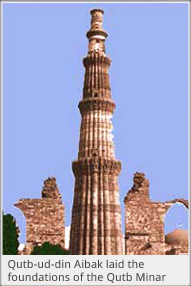The concept of equality in Islam and Muslim traditions reached its climax in the history of South Asia when slaves were raised to the status of Sultan. The Slave Dynasty ruled the Sub-continent for about 84 years. Qutb-ud-din Aibak, Shams-ud-din Iltutmush and Ghiyas-ud-din Balban, the three great Sultans of the era, were themselves sold and purchased during their early lives. The Slave Dynasty was the first Muslim dynasty that ruled India.
Muhammad Ghuri had no son so he raised thousands of slaves like his sons. Ghuri had the habit to buy every talented slave he came across. He would then train them in the way royal children were trained. During Ghuri’s regime, slaves occupied all key positions in the government machinery. Three favorite slaves of the Sultan were Qutb-ud-din Aibak, Taj-ud-din Ildiz and Nasir-ud-din Qubachah. He appointed them governors of Delhi, Ghazni and Lahore, respectively. Ghuri never nominated his successor but it was obvious that the successor was to be one of his slaves.
When Ghuri died in 1206, the amirs elected Aibak as the new Sultan. Aibak first shifted his capital from Ghazni to Lahore and then from Lahore to Delhi. Thus he was the first Muslim ruler who ruled South Asia and had his headquarters in the region as well. Aibak could only rule for four years and died in 1210. He was succeeded by his son Aram Shah, who proved to be too incompetent to hold such an important position. The Turk nobles invited Iltutmush, one of the slaves and son-in-law of Aibak, to assume charge of the state affairs. Iltutmush ruled for around 26 years from 1211 to 1236 and was responsible for setting the Sultanate of Delhi on strong footings.
After the death of Iltutmush, a war of succession started between his children. First Rukn-ud-din Firuz sat on the throne for seven months. He was replaced by Razia Sultana. Another son of Iltutmush, Bahram, took over from Razia Sultana in 1239. Next, Masud, son of Rukn-ud-din Firuz, became Sultan from 1242 to 1245. Finally the youngest son of Iltutmush, Nasir-ud-din Mahmud became Sultan in 1245. Though Mahmud ruled India for around 20 years, but throughout his tenure the main power remained in the hands of Balban. On death of Mahmud, Balban directly took over the throne and ruled Delhi. During his rule from 1266 to 1287, Balban consolidated the administrative set up of the empire and completed the work started by Iltutmush.
 Prince Muhammad, who was trained as the successor of Balban, was killed in one of the battles against Mongols during his fathers’ lifetime. This created a vacuum for a good successor and it was not possible for the incompetent rulers who followed Balban, to meet the administrative standards set by their predecessor. Balban was succeeded by his seventeen years old grandson, Kaiqubad. Kaiqubad started spending his wealth on pursuits of pleasure. The practical affairs of the government went into the hands of Malik Nizam-ud-din. Nizam-ud-din murdered all the nobles and princes who were against him. Later on, differences arose between Kaiqubad and Nizam-ud-din and Kaiqubad killed Nizam-ud-din. Kaiqubad suffered a stroke and was paralyzed. His nobles replaced him by his three years old son Kaimurs. On June 13, 1290, Firuz, a Khalji Malik and the Ariz-i-Mumalik appointed by Kaiqubad, took over the throne from the infant Sultan and declared his independence with the title of Jalal-ud-din Khalji. With this the rule of the Slave Dynasty came to an end.
Prince Muhammad, who was trained as the successor of Balban, was killed in one of the battles against Mongols during his fathers’ lifetime. This created a vacuum for a good successor and it was not possible for the incompetent rulers who followed Balban, to meet the administrative standards set by their predecessor. Balban was succeeded by his seventeen years old grandson, Kaiqubad. Kaiqubad started spending his wealth on pursuits of pleasure. The practical affairs of the government went into the hands of Malik Nizam-ud-din. Nizam-ud-din murdered all the nobles and princes who were against him. Later on, differences arose between Kaiqubad and Nizam-ud-din and Kaiqubad killed Nizam-ud-din. Kaiqubad suffered a stroke and was paralyzed. His nobles replaced him by his three years old son Kaimurs. On June 13, 1290, Firuz, a Khalji Malik and the Ariz-i-Mumalik appointed by Kaiqubad, took over the throne from the infant Sultan and declared his independence with the title of Jalal-ud-din Khalji. With this the rule of the Slave Dynasty came to an end.
 The most important institution that developed under the Slave Dynasty was the institution of Chalgan or the Forty. Chalgan were a corps of highly placed and powerful officers, whom Iltutmush had organized as his personal supporters. They were like the cabinet for the Sultan. However, during the days of civil war between the successors of Iltutmush, the Chalgan started looking for their personal gains and played one prince against the other. During this era they became very strong. Each one of them started considering himself as the deputy of the Sultan. When Balban assumed charge as Sultan, he murdered some of them while others were banished from the kingdom. There is no doubt that by crushing their power, Balban strengthened his rule, but actually he destroyed the real power of the slave dynasty.
The most important institution that developed under the Slave Dynasty was the institution of Chalgan or the Forty. Chalgan were a corps of highly placed and powerful officers, whom Iltutmush had organized as his personal supporters. They were like the cabinet for the Sultan. However, during the days of civil war between the successors of Iltutmush, the Chalgan started looking for their personal gains and played one prince against the other. During this era they became very strong. Each one of them started considering himself as the deputy of the Sultan. When Balban assumed charge as Sultan, he murdered some of them while others were banished from the kingdom. There is no doubt that by crushing their power, Balban strengthened his rule, but actually he destroyed the real power of the slave dynasty.
This article was last updated on Sunday, June 01, 2003






